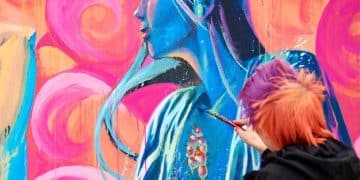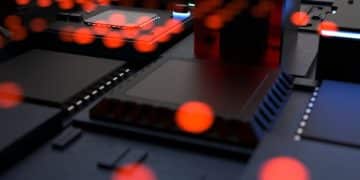Streetwear Customization: DIY Techniques for Personalized Style
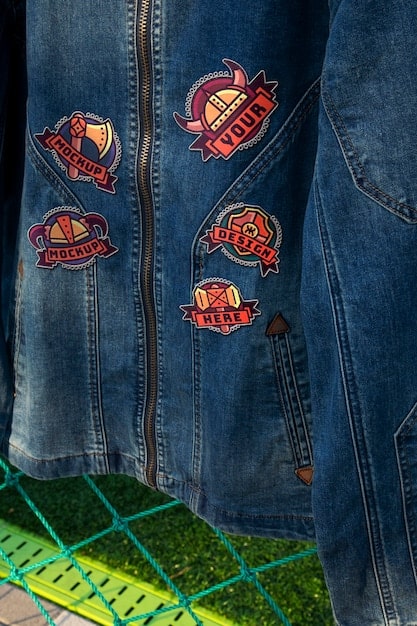
Achieving unique and personalized streetwear involves leveraging various DIY customization techniques, allowing individuals to express their creativity and stand out in the urban fashion landscape by transforming standard garments into bespoke pieces.
In the vibrant world of urban fashion, the concept of conformity is rapidly fading. Today’s streetwear enthusiasts seek authenticity and individuality, traits beautifully expressed through Streetwear Customization: Personalize Your Style with These DIY Techniques. Instead of merely buying off-the-rack pieces, imagine transforming ordinary garments into unique statements that truly reflect your personality and creative vision.
The Canvas of Streetwear: Why Customization Matters
The allure of streetwear lies in its inherent connection to self-expression and cultural identity. Beyond brand logos and limited releases, true individuality often emerges through personalization. Customizing your streetwear isn’t just a trend; it’s a movement that empowers wearers to become designers, injecting their unique narrative into every thread and stitch. This transformation elevates clothing from mere apparel to wearable art, making each piece a testament to personal style.
Beyond Mass Production: The Appeal of Uniqueness
In an era dominated by mass-produced fast fashion, the desire for distinctive items has intensified. Customization offers a refreshing alternative, allowing you to break free from the uniformity of commercial offerings. It’s about creating something that no one else has, a garment that tells your story and stands out from the crowd. This sense of exclusivity fuels the passion for DIY modification within the streetwear community.
The journey of customizing your wardrobe begins with a vision. Perhaps it’s a faded denim jacket yearning for a new life, a plain hoodie awaiting a splash of color, or a pair of sneakers begging for unique details. The process itself is as rewarding as the final product, fostering creativity and a hands-on approach to fashion. It connects you more deeply with your clothes, transforming them from mere possessions into treasured reflections of your artistic spirit.
Ultimately, streetwear customization is an accessible avenue for anyone looking to make a personal statement through their attire. It celebrates ingenuity, sustainability, and the boundless possibilities of design. Whether you’re a seasoned artist or a curious beginner, the tools and techniques available today make it easier than ever to embark on your customization journey and truly personalize your style.
Essential Tools and Materials for Your DIY Projects
Embarking on your streetwear customization journey requires the right arsenal of tools and materials. Having these essentials on hand ensures that your creative vision can be executed effectively and with lasting results. From basic cutting tools to specialized paints and adhesives, each item plays a crucial role in bringing your designs to life. Investing in quality supplies not only makes the process smoother but also enhances the longevity and appearance of your customized pieces.
A Foundation of Basics: What You’ll Always Need
Before diving into specific techniques, gather fundamental supplies that will be useful across almost all projects. These include sharp scissors for fabric, a self-healing cutting mat to protect surfaces, and a good quality fabric adhesive. Additionally, a set of measuring tapes or rulers is invaluable for precise placement and sizing of your designs.
* Fabric Scissors: Essential for clean cuts, crucial when working with patches or deconstruction.
* Self-Healing Mat: Protects your workspace from cuts and provides precise measurements.
* Fabric Adhesive: A versatile tool for quick fixes and strong bonds, especially for patches and embellishments.
* Measuring Tools: Ensures accuracy in design placement and sizing on garments.
Beyond these basics, consider a dedicated workspace where you can spread out and focus without interruption. Good lighting is also paramount to ensure you can see your work clearly and avoid errors. Having everything organized and accessible will streamline your customization process, allowing for maximum creativity and minimum frustration. Preparing your materials beforehand sets you up for success in transforming your streetwear.
Techniques for Fabric Transformation: Dyeing & Bleaching
Altering the color of your garments through dyeing and bleaching offers a dramatic and effective way to customize streetwear. These techniques can create entirely new aesthetics, from vibrant, saturated hues to distressed, faded effects. Mastering them allows for complete control over your fabric’s palette, opening up endless possibilities for unique transformations. It’s a bold step that can fundamentally change the character of a piece.
Dyeing Basics: Adding Color Creatively
Dyeing garments is a fantastic way to introduce new colors or refresh old ones. Fabric dyes come in various forms, including liquid, powder, and tie-dye kits, each offering different applications and effects. For vibrant, even colors, immersion dyeing is often preferred.
* Immersion Dyeing: Submerge the entire garment in a dye bath for uniform color.
* Tie-Dye: Create intricate patterns by binding sections of fabric before dyeing, leading to unique resist effects.
* Dip-Dye: Gradually submerge part of the garment to achieve an ombre or gradient effect.
When dyeing, always follow the manufacturer’s instructions regarding fabric type, water temperature, and dye-to-fabric ratios for optimal results. Pre-washing the garment is also crucial to remove any finishes that might hinder dye absorption. Experimenting with color mixing can lead to truly unique shades that perfectly match your desired aesthetic.
Bleaching Methods: Creating Unique Fades and Patterns
Bleaching, in contrast to dyeing, removes color, offering a powerful way to create distressed looks, faded patterns, or even stark white designs on darker fabrics. Chlorine bleach is the most common agent, but it must be used cautiously due to its corrosive nature.
* Spray Bleach: Dilute bleach in a spray bottle for controlled splatters, fades, or stencil patterns.
* Bleach Tie-Dye: Similar to traditional tie-dye, but bleach is applied to create patterns by removing color.
* Full Bleach: Submerge the garment in a diluted bleach solution for an overall faded or vintage effect.
Always work in a well-ventilated area when using bleach and wear protective gloves to prevent skin irritation. Test a small, inconspicuous area of the garment first to see how the fabric reacts, as different materials can respond differently to bleach. The careful application of bleach can turn a plain item into a piece with striking visual texture and character, perfect for an edgy streetwear look.
Embellishments: Patches, Pins, and Chains
Adding embellishments is one of the most straightforward yet impactful ways to customize streetwear. Patches, pins, and chains provide immediate visual interest, allowing for quick transformations and a high degree of personalization. These elements can convey messages, display affiliations, or simply add vibrant pops of color and texture to any garment. They are fantastic for expressing individuality without permanent alteration to the fabric, offering flexibility in design.
Patches and Pins: Expressing Identity and Affiliations
Patches and pins allow you to tell a story on your clothing. They can commemorate events, showcase interests, or align with subcultures. Patches come in various styles—embroidered, woven, printed—and can be ironed on, sewn on, or attached with fabric glue. Pins, on the other hand, offer an even quicker way to accessorize, as they can be easily moved and rearranged.
* Placement: Consider strategic placement on jackets, jeans, or bags for maximum impact.
* Layering: Overlap patches or group pins together for a more dynamic, layered look.
* Theme: Curate patches and pins around a specific theme or color palette to create a cohesive design.
When applying iron-on patches, always use a pressing cloth and apply even pressure and heat. For a more secure and long-lasting attachment, especially on items that will be frequently washed, sewing patches on by hand or machine is recommended. Pins offer versatility, allowing you to instantly change your garment’s statement depending on your mood or the occasion.
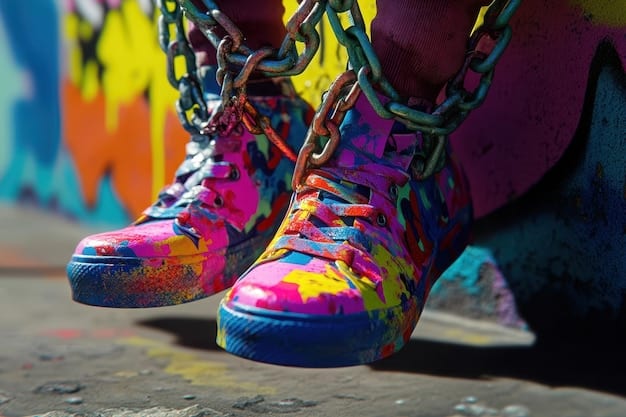
Chains and Hardware: Adding Edgy Details
Chains, studs, and other metallic hardware lend an edgy, industrial aesthetic to streetwear. These elements can range from subtle accents to prominent decorative features, adding weight, shine, and structural interest to garments. They invoke a sense of rebellion and urban grit, perfect for those who lean towards a more daring style.
* Draping Chains: Attach chains to belt loops, pockets, or sleeves for a fluid, dynamic look.
* Studding: Apply studs or spikes to collars, cuffs, or along seams for a punk-inspired edge.
* Zipper Pulls: Replace standard zipper pulls with custom chain or charm attachments.
When working with hardware, select items that complement the fabric and overall style of your garment. Ensure that any attachments are securely fastened to prevent them from falling off or damaging the fabric. These metallic additions can transform a simple piece into a statement item, emphasizing a bold and unconventional aesthetic that resonates deeply within the streetwear culture.
Painting and Stenciling: Artistic Freedom on Fabric
Fabric painting and stenciling unleash unparalleled artistic freedom, allowing you to apply unique graphics, illustrations, and patterns directly onto your streetwear. This method offers a hands-on approach to design, transforming garments into personalized canvases. With the right techniques and materials, you can achieve vibrant, durable designs that truly reflect your creative vision and stand out from manufactured prints.
Direct Painting: Hand-Drawn Masterpieces
Hand-painting on fabric allows for intricate details and original artwork. It’s a method that truly showcases your artistic skill and can produce one-of-a-kind pieces. Fabric paints are designed to be flexible and durable, withstanding washes without cracking or fading significantly.
* Fabric Choice: Opt for natural fibers like cotton or denim, which absorb paint well.
* Preparation: Wash and iron the garment to create a smooth, clean surface for painting.
* Sketching: Lightly sketch your design onto the fabric with a fabric pencil before painting.
* Layering: Apply thin, even layers of paint, allowing each to dry before adding the next for depth and vibrancy.
When painting, use specialized fabric brushes that hold paint well and provide good control. Heat-setting the paint after it dries, usually by ironing, is crucial for durability, ensuring your artwork remains vibrant and resistant to wear and tear. This technique is ideal for custom illustrations, unique logos, or translating complex ideas directly onto your clothing.
Stenciling: Precision and Repeatable Patterns
Stenciling offers a way to achieve crisp, repeatable designs with relative ease. It’s perfect for creating logos, geometric patterns, or text-based graphics. Stencils can be purchased pre-made, or you can create your own from acetate sheets, cardboard, or even adhesive vinyl.
* Secure the Stencil: Use painter’s tape or temporary fabric adhesive to hold the stencil firmly in place.
* Apply Paint Evenly: Use a sponge or stencil brush to apply fabric paint in thin, even coats, dabbing rather than brushing.
* Remove Carefully: Peel off the stencil slowly while the paint is still slightly damp to avoid smudging.
With stenciling, precision is key. Ensure your stencil adheres completely to avoid paint bleeding underneath. Experiment with different colors and layering stencils for more complex designs. This method is incredibly versatile, allowing you to replicate designs consistently or combine multiple stencil patterns for an intricate, professional-looking finish on your streetwear.
Deconstruction and Reconstruction: Beyond the Stitch
Deconstruction and reconstruction represent the pinnacle of streetwear customization, involving the artful dismantling and reassembly of garments to create entirely new forms. This advanced technique allows for radical transformations, blending different fabrics, shapes, and textures to produce truly unique pieces. It’s a visionary approach that challenges conventional design, resulting in garments that are architectural, layered, and deeply personal.
Surgical Precision: The Art of Deconstruction
Deconstruction involves taking existing garments apart, sometimes partially, sometimes entirely. This process can range from simple cuts and distressing to meticulously dissecting seams and panels. The goal is often to expose underlying structures, create intentional imperfections, or prepare fabric for reassembly in a new way.
* Seam Ripping: Carefully undo existing seams to separate fabric panels for new constructions.
* Strategic Cuts: Create rips, slashes, or cut-outs to reveal layers or add ventilation.
* Fraying and Distressing: Use sandpaper, razors, or brushes to create worn, aged textures.
When deconstructing, precision is vital to avoid irreparable damage. Plan your cuts and unpicking carefully, considering how each alteration will contribute to the final look. Deconstruction is an experimental process that often leads to unexpected yet compelling results, giving garments a raw, unpolished edge that is highly prized in streetwear.
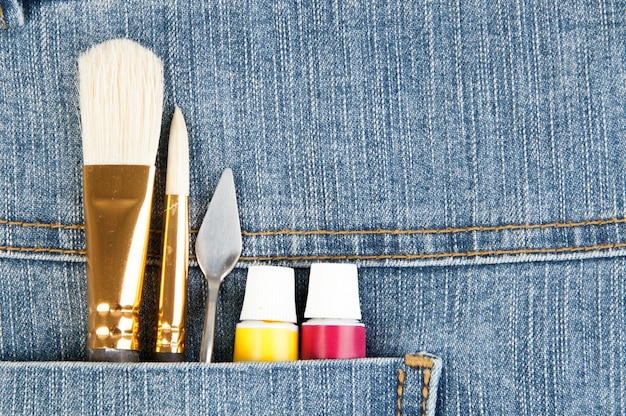
Reimagining Form: The Power of Reconstruction
Reconstruction is where creativity truly flourishes. It involves combining pieces from different garments, adding new elements, or altering the silhouette through sewing and patterning. This technique can transform multiple items into a single, cohesive, and innovative design.
* Patchworking: Combine different fabric scraps or panels from various garments to create unique quilted or pieced designs.
* Layering: Sew multiple layers of fabric or entire garments together for added volume, texture, or visual depth.
* Silhouette Alteration: Add or remove fabric, change seam lines, or integrate new structural elements to modify the garment’s shape.
Reconstruction often requires basic to advanced sewing skills, from hand-stitching to machine operation. Experiment with different fabric combinations and textures to create visually interesting contrasts. This process allows for complete creative control, enabling you to build garments that defy traditional categories, showcasing a truly bespoke and avant-garde approach to streetwear. The result is a piece that is not just customized, but entirely reimagined, embodying a new identity.
Care and Maintenance for Customized Wear
Once you’ve invested time and creativity into customizing your streetwear, proper care and maintenance become essential to preserve your unique creations. Customized garments, especially those involving dyes, paints, or delicate embellishments, often require special attention to ensure their longevity and keep them looking their best. Neglecting proper care can lead to fading, cracking, or deterioration of your customized elements, undermining all your hard work.
Preserving Your Art: Washing and Drying Tips
How you wash and dry your customized items significantly impacts their lifespan. Aggressive washing can damage painted surfaces, loosen patches, and fade dyes. Hand-washing or using a gentle machine cycle is often recommended, along with specific water temperatures.
* Turn Inside Out: Always turn customized garments inside out before washing to protect delicate embellishments and painted surfaces from friction.
* Cold Water Wash: Use cold water to prevent dye bleeding and minimize shrinkage.
* Gentle Cycle: Select a gentle or delicate cycle on your washing machine.
* Mild Detergent: Opt for a mild, color-safe detergent to avoid harsh chemicals that could strip colors or damage materials.
* Air Dry: Whenever possible, air dry your customized pieces flat or hang them to prevent distortion and reduce wear on customizations. Avoid high heat from tumble dryers.
For items with particularly fragile embellishments like chains or intricate hand-painting, spot cleaning may be the safest option. If machine washing is necessary, consider placing the item in a mesh laundry bag to provide an extra layer of protection. These preventive measures are crucial for maintaining the integrity and vibrancy of your unique designs over time.
Long-Term Preservation: Storage and Repairs
Beyond regular washing, how you store and care for your customized streetwear between wears contributes to its long-term preservation. Proper storage helps prevent damage, dust accumulation, and deformation. Being prepared to make minor repairs can also significantly extend the life of your customized pieces, addressing issues before they become major problems.
* Proper Storage: Store garments neatly folded or on appropriate hangers to maintain shape. Avoid overcrowding closets.
* Light Exposure: Keep customized items away from direct sunlight for prolonged periods, as UV rays can cause fading.
* Spot Repair Kits: Have a small kit with fabric glue, thread, and needles on hand for quick patch reattachments or minor seam repairs.
* Professional Cleaning: For highly intricate or heavily embellished items, consider professional dry cleaning if recommended or if you are unsure how to clean them safely yourself.
Addressing small issues like loose threads or peeling patches promptly can prevent them from worsening. Regularly inspect your customized items for any signs of wear and tear, especially around the areas of modification. By implementing these care and maintenance practices, you ensure that your personalized streetwear remains a cherished and stylish part of your wardrobe for years to come, showcasing your enduring creativity.
| Key Customization Method | Brief Description |
|---|---|
| 🎨 Dyeing & Bleaching | Transform garment color and create unique patterns (ombre, tie-dye, distressed fades) by adding or removing pigment. |
| 🧵 Patches & Pins | Add expressive elements, affiliations, and visual interest using sew-on, iron-on patches, and removable decorative pins. |
| 🖌️ Painting & Stenciling | Directly apply original artwork or repeatable designs onto fabric using specialized paints and stencils for vibrant results. |
| ✂️ Deconstruction & Reconstruction | Dismantle and reassemble garments, blending fabrics and altering silhouettes to create entirely new, unique designs. |
Frequently Asked Questions About Streetwear Customization
▼
Natural fibers like cotton and denim are generally best for most customization techniques, especially dyeing and painting, as they absorb products well and are durable. Synthetic blends can also work, but always test on a small area first as they may react differently to dyes or adhesives.
▼
Durability hinges on proper application and care. For paints, heat-setting is crucial. For patches, sewing offers more security than ironing. Always use high-quality fabric-specific products, follow instructions diligently, and wash customized items gently, typically inside out and cold water, avoiding harsh dryers.
▼
Beginners can start with simple techniques like adding iron-on patches or using fabric markers for hand-drawn accents. Tie-dyeing old t-shirts is also a fun and forgiving entry point. These methods require minimal specialized tools and allow for creative expression without major commitment.
▼
Yes, many techniques adapt well to sneakers, though specific materials require specialized products. Fabric paints designed for sneakers, waterproof markers, and durable adhesives for attaching patches or unique laces are popular choices. Ensure the surface is clean and prepped before applying any customization.
▼
Inspiration can come from anywhere! Explore social media platforms like Instagram and Pinterest for customized streetwear accounts, look at vintage clothing, art, and even nature. Attending local craft fairs or art shows can also spark ideas by observing different creative expressions and techniques.
Conclusion
Streetwear Customization: Personalize Your Style with These DIY Techniques isn’t just about altering clothes; it’s about reclaiming originality and celebrating individual expression in a world often dominated by mass trends. From the vibrant possibilities of dyeing and bleaching to the intricate details of patches and paints, and the bold statements of deconstruction, each technique offers a pathway to making your garments uniquely yours. Embracing DIY customization empowers you to transform your wardrobe into a canvas of creativity, reflecting your personal narrative with every stitch and stroke. It’s an ongoing journey of artistic exploration, ensuring your style remains as dynamic and authentic as you are.
